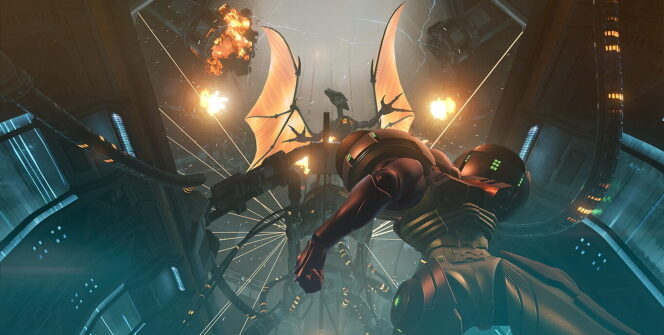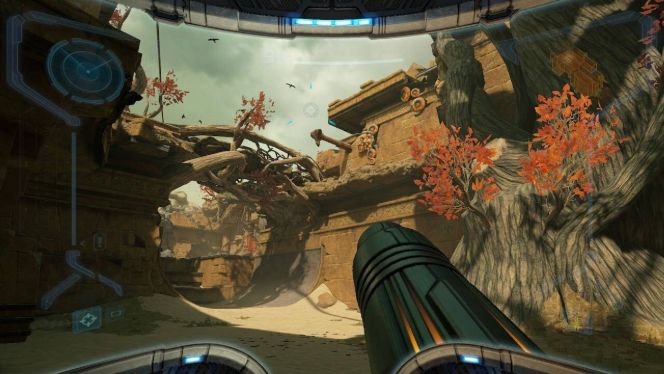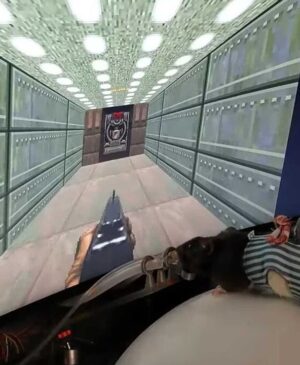REVIEW – The long-rumored and supposedly been-done-for-a-while Metroid Prime trilogy remastered for the Nintendo Switch has been partially released, with only the first episode available on the Nintendo eShop. Still, the second and third episodes with a darker tone will come later. In the meantime, here’s the first one, released over twenty years ago, and it looks like it’s not a bad facelift.
One could point to the remaster’s lack of QoL (quality-of-life) features as a flaw, but if Retro Studios was aiming for an authentic experience, that’s not going to be an issue for many…
From GameCube to Switch
One thing to know about the Metroid Prime games is that they are not side-view platformers (and not 3D platformers like Metroid: Other M was) but first-person shooters and platformers (you can’t and shouldn’t deviate from the basics). Graphically, Retro Studios seemed to have done everything in their power to make Nintendo regret their original idea: it wouldn’t be surprising if the team began working on the project a long time ago, while the big N had entrusted the Metroid Prime 4 project to Bandai Namco’s studios in Japan and Singapore, by which time the original developers had gone to the trouble of making Nintendo regret the move (which they probably did, as they gave the development back to Retro). Graphically, it’s a nearly flawless remaster, and it’s running in a 16:9 aspect ratio. The studio has stayed true to the original game, but the detail and complexity have been increased. Still, the lighting takes the game to a new level, with one minor shortcoming compared to the original: the beam weapons don’t have dynamic lighting.
It may not be noticeable at first, but when the two games are placed side by side, this minor setback will rear its head. There will be some locations where Samus is not reflected, but with aging hardware, it should be understandable. The models and textures have been redone, which was the right decision as the visuals from 2002 would be hard to sell with this IP nowadays. The levels are also built geometrically as we remember them. The cutscenes and animations are identical to the original, and only the camera has been tweaked. Thus, we can say that Retro Studios (and co-developer Iron Galaxy) have given the game a solid visual overhaul. There are minor details lacks while providing extras (the effect of raindrops while using your cannon), so in that respect, it’s safe to give the remaster an excellent rating (this bunch of characters aims to discuss what has changed from the GameCube original), which Nintendo quietly released quite unexpectedly during its Nintendo Direct last week. (Given that Microsoft did a similar thing with Tango Gameworks’ Hi-Fi Rush this year, it’s something to be prepared for.)
Hand ling
For a remaster of this weight, the controls can spoil the result and the experience, but thankfully, Retro hasn’t slipped on that banana peel. You have the option of the original control model, but you get the modernized option as standard. On top of that, you have the Wii-style gyroscope solution or a mix of the two (classic model + gyroscope-based free aiming solution). So everyone is sure to find a control model that suits them. There’s no need to worry about performance. Metroid Prime Remastered runs at 900p when docked and 600p in handheld mode, maintaining a stable 60 FPS frame rate but without anti-aliasing. There’s not much to talk about load times, either.
It’s there when firing up the game, and it also occurs while using elevators, but now, there’s no stopping for a few moments when opening doors (it was noticeable on the GameCube). So it’s an outstanding job in these aspects, as there are nuanced innovations, yet they’ve been implemented. Conveniently, though, you might have thought it was a handheld platform. So maybe the automatic saving could have been thought of (because, who knows, someone might simply forget to save when getting off the bus…). Fast traveling shouldn’t even be brought up, as it’s a flaw of the base game that you often have to turn back to areas you’ve already seen, and backtracking can be expected for someone who doesn’t know the game map like the back of their hand.
A great start
If the second and third remasters are up to the same standard, all three games will be among the finest Nintendo Switch titles (with The Legend of Zelda: Tears of the Kingdom perhaps taking the throne in the spring visually). The game would deserve an 8.5 out of 10 for being somewhat annoying with backtracking. The remaster is a 9.5 out of 10 for its lack of convenience features, and a 9/10 rating is justified when it is compared. This is how to do a decent remake of a game that wants to slowly shift the focus to Metroid Prime 4 (if Nintendo doesn’t reveal it this summer, they’ll be making a colossal mistake… unless they’ve pushed development to the Switch successor…?). But $40 for it is a lot: why can’t it be twenty dollars? Somewhat of a ripoff there, Nintendo…
-V-
Pro:
+ Multiple treatment schemes
+ A very careful graphic rethinking
+ Its performance is almost perfect
Contra:
– Maybe autosave could be part of the game
– Less sacrifice in resolution (900p)
– A bit expensive…
Publisher: Nintendo
Developer: Retro Studios, Iron Galaxy
Style: action-adventure with an inside view
Release: February 8, 2023.
Metroid Prime Remastered
Gameplay - 8.6
Graphics - 9.4
Story - 9.2
Music/Audio - 8.8
Ambience - 9
9
EXCELLENT
Samus' death sound is just as scary today.
















